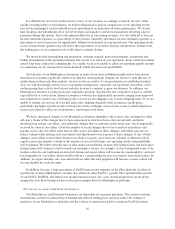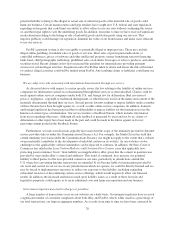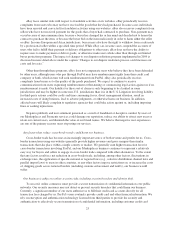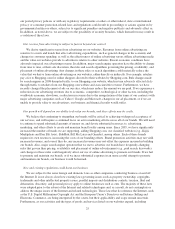eBay 2009 Annual Report Download - page 30
Download and view the complete annual report
Please find page 30 of the 2009 eBay annual report below. You can navigate through the pages in the report by either clicking on the pages listed below, or by using the keyword search tool below to find specific information within the annual report.intermediaries such as ourselves are either unclear or less favorable. Any claims or regulatory actions against us,
whether meritorious or not, could be time consuming, result in costly litigation, damage awards, injunctive relief,
or increased costs of doing business through adverse judgment or settlement, require us to change our business
practices in expensive ways, require significant amounts of management time, result in the diversion of
significant operational resources, or otherwise harm our business.
Failure to deal effectively with fraudulent transactions and customer disputes would increase our loss rate and
harm our business.
As a result of a policy change implemented in October 2008, buyers who pay for transactions on eBay.com
with PayPal are protected on eligible transactions for the full amount of an item’s purchase price (including
original shipping) if the buyer does not receive the goods they purchased or if the goods differ significantly from
what was described by the seller, compared to a maximum recovery of $2,000 before October 2008.
Furthermore, U.S. sellers on eBay.com have received improved seller protection for eligible transactions in
which the seller is paid with PayPal, in that they are covered against payment reversals due to buyer claims of an
unauthorized payment or an item that was not received, so long as the seller follows specified shipping and
handling practices. We have also enhanced our buyer and seller protections in certain eBay international
marketplaces. These changes to PayPal’s buyer and seller protection program could result in future increases and
fluctuations in our Payments transaction loss rate. For the fiscal year ended December 31, 2008 and the fiscal
year ended December 31, 2009, our Payments transaction losses (including both direct losses and buyer
protection payouts) totaled $171.5 million and $180.9 million, representing 0.29% and 0.25% of our net total
payment volume in each period, respectively.
In addition, in 2009 we changed the dispute resolution process for transactions on eBay.com and
eBay.co.uk, which are described in greater detail above under the caption “Changes to our dispute resolution
program could increase our costs and loss rate” and which could result in an increase in our combined eBay and
PayPal transaction losses.
PayPal’s highly automated and liquid payment service makes PayPal an attractive target for fraud. In
configuring its service, PayPal continually strives to maintain the right balance of appropriate measures to
promote both convenience and security for customers. Identity thieves and those committing fraud using stolen
credit card or bank account numbers can potentially steal large amounts of money from businesses such as
PayPal. We believe that several of PayPal’s current and former competitors in the electronic payments business
have gone out of business or significantly restricted their businesses largely due to losses from this type of fraud.
While PayPal uses advanced anti-fraud technologies, we expect that technically knowledgeable criminals will
continue to attempt to circumvent PayPal’s anti-fraud systems using increasingly sophisticated methods. In
addition, PayPal’s service could be subject to employee fraud or other internal security breaches, and PayPal may
be required to reimburse customers for any funds stolen as a result of such breaches. Merchants could also
request reimbursement, or stop using PayPal, if they are affected by buyer fraud or other types of fraud.
PayPal incurs substantial losses from merchant fraud, including claims from customers that merchants have
not performed or that their goods or services do not match the merchant’s description. PayPal also incurs losses
from claims that the customer did not authorize the purchase, from buyer fraud, from erroneous transmissions, and
from customers who have closed bank accounts or have insufficient funds in them to satisfy payments. In addition
to the direct costs of such losses, if they are related to credit card transactions and become excessive, they could
potentially result in PayPal losing the right to accept credit cards for payment. If PayPal were unable to accept
credit cards, the velocity of trade on eBay could decrease and result in corresponding decreases in our net total
payment volume, in which case our business would further suffer. Bill Me Later is similarly subject to the risk of
fraudulent activity associated with merchants, users of the Bill Me Later service and third parties handling its user
information, which could increase our exposure to transaction losses and reduce the profitability of Bill Me
Later’s business. Our Payments business has taken measures to detect and reduce the risk of fraud, but these
measures need to be continually improved and may not be effective against new and continually evolving forms of
fraud or in connection with new product offerings. If these measures do not succeed, our business will suffer.
22
























